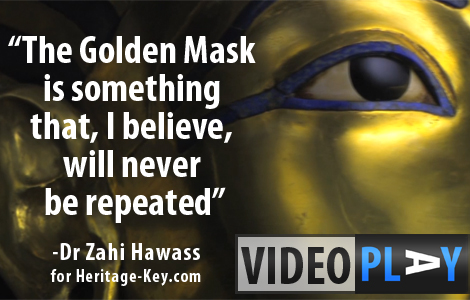 When Howard Carter said he spied wondrous things upon cracking open the tomb of Tutankhamun in 1922, he wasnt joking. KV62 was filled with probably the most fantastic collection of ancient treasures ever discovered in one place all from beautiful golden coffins, to giant statues, canopic shrines and a golden throne. Tuts own body was literally stuffed with precious jewellery.
When Howard Carter said he spied wondrous things upon cracking open the tomb of Tutankhamun in 1922, he wasnt joking. KV62 was filled with probably the most fantastic collection of ancient treasures ever discovered in one place all from beautiful golden coffins, to giant statues, canopic shrines and a golden throne. Tuts own body was literally stuffed with precious jewellery.
In the third instalment of our four-part video series King Tut Revealed filmed by Nico Piazza, and featuring still photography by Sandro Vannini Dr Zahi Hawass, who you can watch in this video revealing the cause of Tuts death and sharing his thoughts on the curse of Tutankhamun(Watch this video by clicking here), tells us about his personal favourites among the many treasures of King Tuts tomb, a large number of which are currently on display at the Egyptian Museum in Cairo.
The Golden Death Mask and the Coffins
I believe it is something that will never be repeated, says Hawass of his first selection, the golden death mask probably the most famous and iconic of all the artefacts found in Tutankhamuns tomb. No artist in the world will be ever be able to repeat it, he says, as were shown some of Sandro Vanninis wonderfully vivid shots of the radiant, enchanting 11kg likeness of the boy king, which was found laid over his face. It is a masterpiece of art, in my opinion, Hawass adds.
Tuts body was discovered lying inside a large nest of coffins. Seven coffins total were found in the tomb (all except one have been removed) its these that Hawass next selects among his favourite treasures. Each coffin can give you amazing and beautiful art, he says, before pointing out how the engravings upon them dont all necessarily portray Tutankhamun as he really looked some of them show Tut as he perhaps wished he looked (he wasn’t the prettiest of chaps, it must be said). Some of what you discover in the tomb is the idealistic life of what he wanted to be, Hawass explains, it is not really realistic art.
The Golden Throne
When Hawass himself visits the Cairo Museum, whats the first artefact he goes to look at? I go to the golden throne, he reveals, another masterpiece. Why? Because, beneath that gruff exterior, Dr Zahis a big old romantic at heart. The most amazing thing they showed in that statue, he explains, a small tear possibly forming in the corner of his eye, is the love between the king and the queen.
The eagle-eyed viewer will observe that, in the detailed raised image set on the back-panel of the golden throne, showing the boy king and his bride Queen Ankhesenamun relaxing in a garden pavilion, both figures are only wearing one sandal. So they both got dressed in a rush that morning, right? Wrong: Theyre wearing one sandal only to show that they are sharing everything, explains Hawass. The love was between them, and this is why when King Tut died, Queen Ankhesenamun was so upset. She put a flower it was discovered on his mummy. Sniff pass the Kleenex!

The Jewellery
The jewellery is amazing, says Hawass, of his final selection among the treasure of King Tuts tomb. Over 104 individual pieces of jewellery including beads, bracelets, rings, amulets and necklaces were found crammed inside the mummy of Tut, as well as strewn around his treasury. They were made from combinations of the most valuable materials the kingdom of Egypt had to offer. The opulence of this pharaohs burial is not to be underestimated.
Hawasss favourite piece is a necklace with a winged scarab (some parts of which, it’s been speculated, come from glass created by a meteor), made from gold, silver, glass and semi-precious stones. Holding the Horus eye and this is a symbol of Osiris are the two cobras, he describes, protecting the king in between. And down, look at the lotus flower. This is in my opinion, a masterpiece. Such tiny, meticulous details in a jewellery item reveal a much larger picture about what inspired artists in ancient Egypt. Art in ancient Egypt was for the sake of religion, according to Dr Hawass.
Coming soon: the final instalment of King Tut Revealed, in which Hawass talks about why King Tuts tomb avoided robbery as others were plundered.
HD Video: King Tut Revealed (Part 3/4) The Treasure
(Click here for the transcript of this video)
Be it insights into the search for the tomb of Cleopatra, sneak peeks at the treasures of King Tuts tomb or new revelations on the riddle of KV63, were videos crazy here at Heritage Key. Sign-up to our RSS feed and get new clips delivered straight to your inbox as soon as they go online. Alternatively, keep an eye on our videos page, where you can take a look at all of our videos to date.